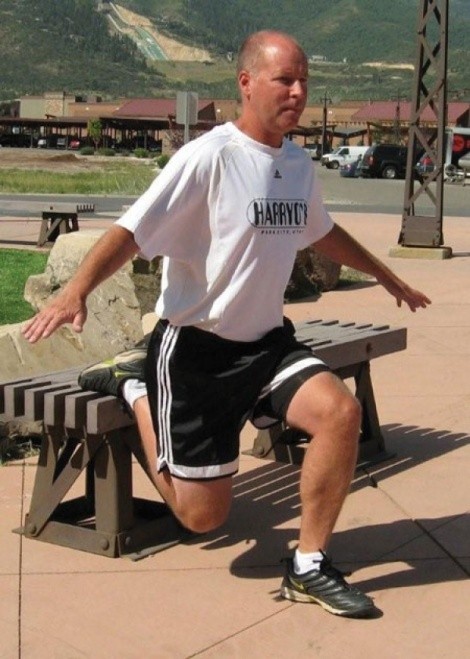
It’s hot. It’s still summer. Why in the world should you think about snowy slopes in August?
Answer: Because it takes at least four
months to build the muscle, power and
endurance you need if you’re a hardcore
skier, free skier or ski racer, whether
Masters, Nastar or Town Challenge. Start
now, and you’ll be strong, powerful and
ready for the season when the lifts start up
again. Even if you’re not a ski racer, training
like one will build your body to better
than you thought it could be.
Masters champion Mike Falk knows
how to train. He’s one of the fastest racers
in the Intermountain division and
has won both the Masters nationals and
regionals. There’s no diamond so black
that he can’t tuck it. But, he advises skiers
to start off easy.
“Get on your bike—mountain, road,
even unicycle, it doesn’t matter. Cycling
builds up cardio and imitates a lot of the
leg movements of racing or skiing bumps
and rough terrain. Mountain biking is better
than road riding for skiing; it works
your balance and core strength,” he says.
But, don’t just poke along; do interval
training. Falk says to sprint, then ride
along placidly until your heart rate returns
to normal, then sprint again. As for the
sprint duration, Falk says, “A regular ski
run is one to three minutes, so you have to
work out in a way that allows you to go for
that long.”
His favorite training exercise is the onelegged
squat because it super-sizes the
workout on your quads and hamstrings
and trains your balance at the same time.
Falk says the exercise is a good one for any
active person. “It’s one of the best exercises
you can do anywhere on the planet, and you
don’t even need a gym to do it,” he says.
Start one-legged squats with only your
body weight. Put one foot behind you on
a chair or bench. For increased balance
work, use an exercise ball. Slowly squat
down until your front thigh is parallel to
the f loor, then slowly stand back up. At
first, you may need to hold on to a wall
or table for support. Start with five reps,
then repeat with the other foot behind
you. Do three times a week. When five
reps get easy, increase to 10. When 10
get easy, start doing the exercise while
holding dumbbells.
Many skiers make the mistake of thinking
they don’t need to work their upper
bodies. But carving down the mountain
uses all the muscles—biceps, triceps, core,
back and chest. Falk advises doing what
he calls the “classic trio”: pull-ups, dips
and curls.
“Those three exercises alone are great
for your upper body. You may want to augment
them with others, like the bench
press, but dips, pull-ups and curls will get
your upper body strong,” he says.
The expert skier also advises a little plyometric work, a type of exercise that trains the body to make fast and powerful movements. At this point of the pre-season, he suggests using a jump rope for at least five minutes every other day.
A skier’s training, whether for tricks,
racing or big mountain, is based on periodization,
which means constantly conditioning
the body to accept a higher level
of training. Falk describes it as an upsidedown
pyramid. “As you get more fit, you
can do more and harder exercises,” he
says—and, of course, the more fit you are,
the easier those hard exercises will be.
Falk sums it up succinctly: “There’s no
doubt that the stronger you are, the faster
you’ll be and the bigger you can go.”